CHEVROLET CITY EXPRESS 2018 Owner's Manual
Manufacturer: CHEVROLET, Model Year: 2018, Model line: CITY EXPRESS, Model: CHEVROLET CITY EXPRESS 2018Pages: 287, PDF Size: 4.19 MB
Page 181 of 287
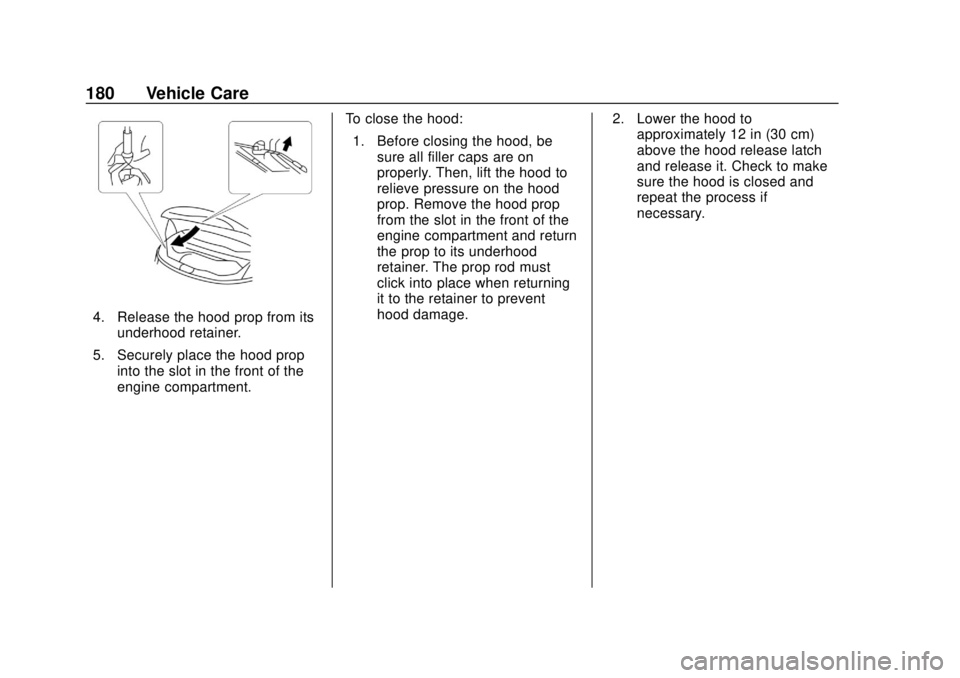
Chevrolet City Express Owner Manual (GMNA-Localizing-U.S./Canada-
11683523) - 2018 - CRC - 7/10/17
180 Vehicle Care
4. Release the hood prop from itsunderhood retainer.
5. Securely place the hood prop into the slot in the front of the
engine compartment. To close the hood:
1. Before closing the hood, be sure all filler caps are on
properly. Then, lift the hood to
relieve pressure on the hood
prop. Remove the hood prop
from the slot in the front of the
engine compartment and return
the prop to its underhood
retainer. The prop rod must
click into place when returning
it to the retainer to prevent
hood damage. 2. Lower the hood to
approximately 12 in (30 cm)
above the hood release latch
and release it. Check to make
sure the hood is closed and
repeat the process if
necessary.
Page 182 of 287
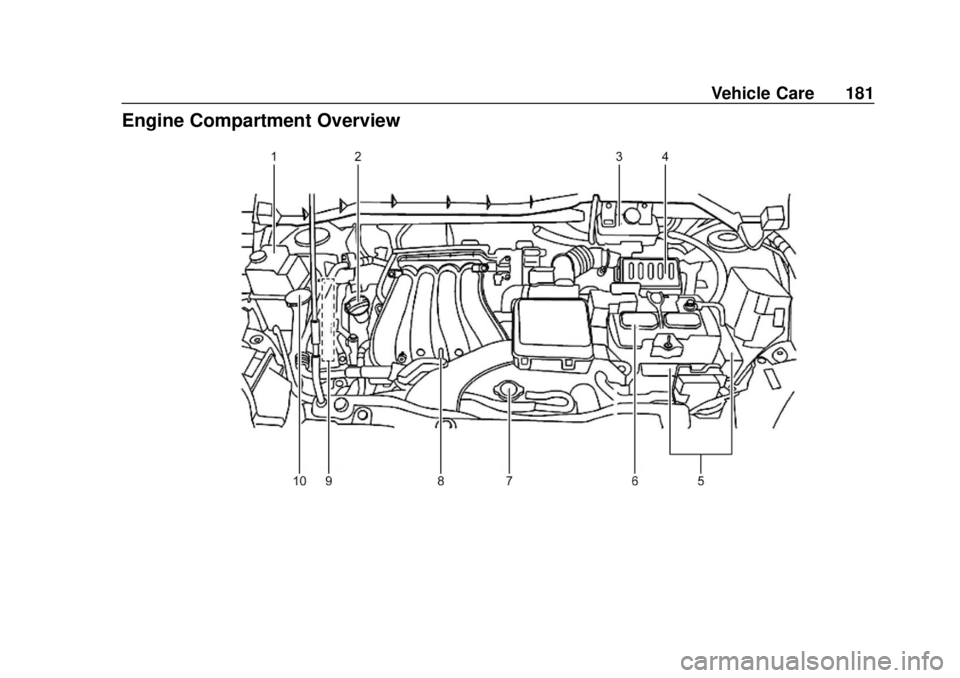
Chevrolet City Express Owner Manual (GMNA-Localizing-U.S./Canada-
11683523) - 2018 - CRC - 7/10/17
Vehicle Care 181
Engine Compartment Overview
Page 183 of 287
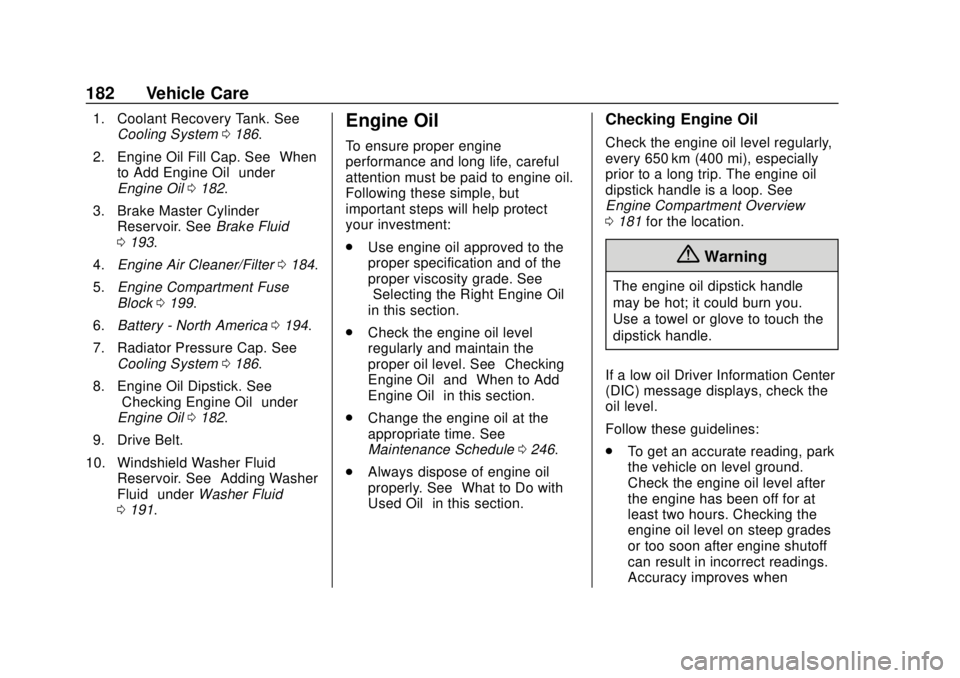
Chevrolet City Express Owner Manual (GMNA-Localizing-U.S./Canada-
11683523) - 2018 - CRC - 7/10/17
182 Vehicle Care
1. Coolant Recovery Tank. SeeCooling System 0186.
2. Engine Oil Fill Cap. See “When
to Add Engine Oil” under
Engine Oil 0182.
3. Brake Master Cylinder Reservoir. See Brake Fluid
0 193.
4. Engine Air Cleaner/Filter 0184.
5. Engine Compartment Fuse
Block 0199.
6. Battery - North America 0194.
7. Radiator Pressure Cap. See Cooling System 0186.
8. Engine Oil Dipstick. See “Checking Engine Oil” under
Engine Oil 0182.
9. Drive Belt.
10. Windshield Washer Fluid Reservoir. See “Adding Washer
Fluid” under Washer Fluid
0 191.Engine Oil
To ensure proper engine
performance and long life, careful
attention must be paid to engine oil.
Following these simple, but
important steps will help protect
your investment:
.
Use engine oil approved to the
proper specification and of the
proper viscosity grade. See
“Selecting the Right Engine Oil”
in this section.
. Check the engine oil level
regularly and maintain the
proper oil level. See “Checking
Engine Oil” and“When to Add
Engine Oil” in this section.
. Change the engine oil at the
appropriate time. See
Maintenance Schedule 0246.
. Always dispose of engine oil
properly. See “What to Do with
Used Oil” in this section.
Checking Engine Oil
Check the engine oil level regularly,
every 650 km (400 mi), especially
prior to a long trip. The engine oil
dipstick handle is a loop. See
Engine Compartment Overview
0181 for the location.
{Warning
The engine oil dipstick handle
may be hot; it could burn you.
Use a towel or glove to touch the
dipstick handle.
If a low oil Driver Information Center
(DIC) message displays, check the
oil level.
Follow these guidelines:
. To get an accurate reading, park
the vehicle on level ground.
Check the engine oil level after
the engine has been off for at
least two hours. Checking the
engine oil level on steep grades
or too soon after engine shutoff
can result in incorrect readings.
Accuracy improves when
Page 184 of 287

Chevrolet City Express Owner Manual (GMNA-Localizing-U.S./Canada-
11683523) - 2018 - CRC - 7/10/17
Vehicle Care 183
checking a cold engine prior to
starting. Remove the dipstick
and check the level.
. If unable to wait two hours, the
engine must be off for at least
15 minutes if the engine is
warm, or at least 30 minutes if
the engine is not warm. Pull out
the dipstick, wipe it with a clean
paper towel or cloth, then push it
back in all the way. Remove it
again, keeping the tip down, and
check the level.
When to Add Engine Oil
It should be between the H (High)
and L (Low) marks after the engine
has been off for at least 15 minutes,
This is the normal operating oil level
range. If the oil level is below the L (Low) mark, remove the oil filler
cap and pour recommended oil
through the opening. See
Engine
Compartment Overview 0181 for
the location of the engine oil fill cap.
Add some of the recommended oil
and then recheck the level. See
“Selecting the Right Engine Oil” in
this section for an explanation of
what kind of oil to use. For engine
oil crankcase capacity, see
Capacities and Specifications 0261.
Add enough oil to put the level
somewhere in the proper operating
range. Do not overfill. Push the
dipstick all the way back in when
through.
Caution
Do not add too much oil. Oil
levels above or below the
acceptable operating range
shown on the dipstick are harmful
to the engine. If you find that you
have an oil level above the
operating range, i.e., the engine
(Continued)
Caution (Continued)
has so much oil that the oil level
gets above the cross-hatched
area that shows the proper
operating range, the engine could
be damaged. You should drain
out the excess oil or limit driving
of the vehicle and seek a service
professional to remove the
excess amount of oil.
Selecting the Right Engine Oil
Selecting the right engine oil
depends on both the proper oil
specification and viscosity grade.
SeeRecommended Fluids and
Lubricants 0257.
Specification
Ask for and use engine oils that
meet the dexos1™ specification.
Engine oils that have been
approved by GM as meeting the
dexos1 specification are marked
with the dexos1 approved logo. See
www.gmdexos.com.
Page 185 of 287
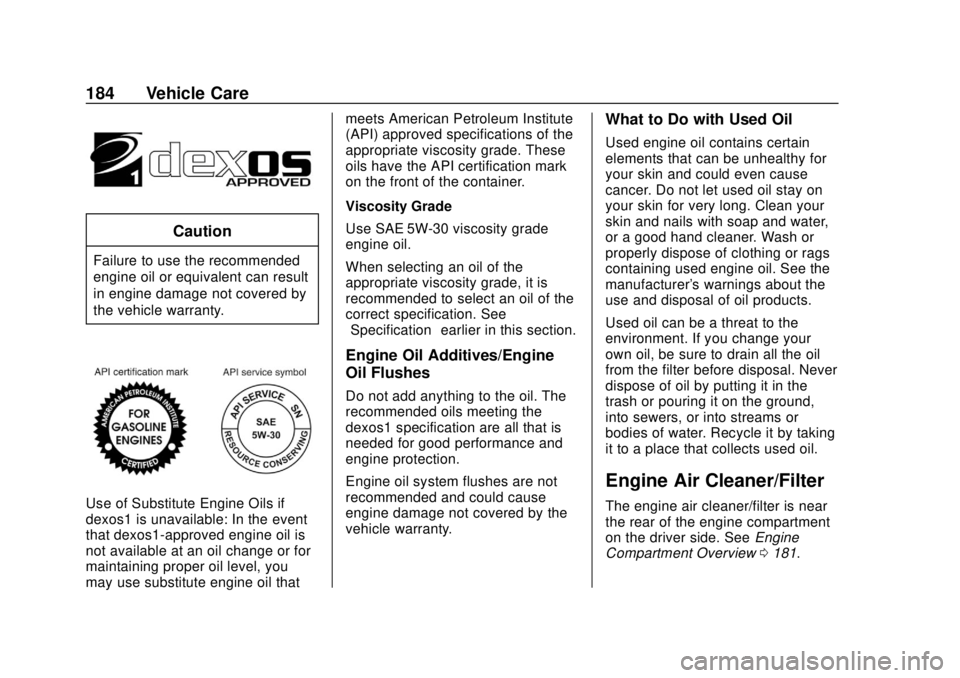
Chevrolet City Express Owner Manual (GMNA-Localizing-U.S./Canada-
11683523) - 2018 - CRC - 7/10/17
184 Vehicle Care
Caution
Failure to use the recommended
engine oil or equivalent can result
in engine damage not covered by
the vehicle warranty.
Use of Substitute Engine Oils if
dexos1 is unavailable: In the event
that dexos1-approved engine oil is
not available at an oil change or for
maintaining proper oil level, you
may use substitute engine oil thatmeets American Petroleum Institute
(API) approved specifications of the
appropriate viscosity grade. These
oils have the API certification mark
on the front of the container.
Viscosity Grade
Use SAE 5W-30 viscosity grade
engine oil.
When selecting an oil of the
appropriate viscosity grade, it is
recommended to select an oil of the
correct specification. See
“Specification”
earlier in this section.
Engine Oil Additives/Engine
Oil Flushes
Do not add anything to the oil. The
recommended oils meeting the
dexos1 specification are all that is
needed for good performance and
engine protection.
Engine oil system flushes are not
recommended and could cause
engine damage not covered by the
vehicle warranty.
What to Do with Used Oil
Used engine oil contains certain
elements that can be unhealthy for
your skin and could even cause
cancer. Do not let used oil stay on
your skin for very long. Clean your
skin and nails with soap and water,
or a good hand cleaner. Wash or
properly dispose of clothing or rags
containing used engine oil. See the
manufacturer's warnings about the
use and disposal of oil products.
Used oil can be a threat to the
environment. If you change your
own oil, be sure to drain all the oil
from the filter before disposal. Never
dispose of oil by putting it in the
trash or pouring it on the ground,
into sewers, or into streams or
bodies of water. Recycle it by taking
it to a place that collects used oil.
Engine Air Cleaner/Filter
The engine air cleaner/filter is near
the rear of the engine compartment
on the driver side. See Engine
Compartment Overview 0181.
Page 186 of 287

Chevrolet City Express Owner Manual (GMNA-Localizing-U.S./Canada-
11683523) - 2018 - CRC - 7/10/17
Vehicle Care 185
When to Inspect the Engine Air
Cleaner/Filter
For intervals on changing and
inspecting the engine air cleaner/
filter, seeMaintenance Schedule
0 246.
How to Inspect the Engine Air
Cleaner/Filter
Do not start the engine or have the
engine running with the engine air
cleaner/filter housing open. Before
removing the engine air cleaner/
filter, make sure that the engine air
cleaner/filter housing and nearby
components are free of dirt and
debris. Remove the engine air
cleaner/filter. Lightly tap and shake
the engine air cleaner/filter (away
from the vehicle), to release loose
dust and dirt. Inspect the engine air
cleaner/filter for damage, and
replace if damaged. Do not clean
the engine air cleaner/filter or
components with water or
compressed air. To inspect or replace the engine air
cleaner/filter:
1. Air Cleaner/Filter Cover
2. Air Cleaner/Filter Tabs (2)
1. Push the tabs (2) in at both
ends of the air cleaner/filter
cover (1).
2. Pull the air cleaner/filter cover (1) up from the air
cleaner/filter assembly.
3. Remove the air cleaner holderand filter from the engine air
cleaner/filter housing. Be
careful to dislodge as little dirt
as possible.
4. Clean the engine air cleaner/ filter housing.
5. Remove the air cleaner/filter from the air cleaner holder.
6. Inspect or replace the engine air cleaner/filter. Make sure that
the filter fits properly into the air
cleaner holder.
Page 187 of 287
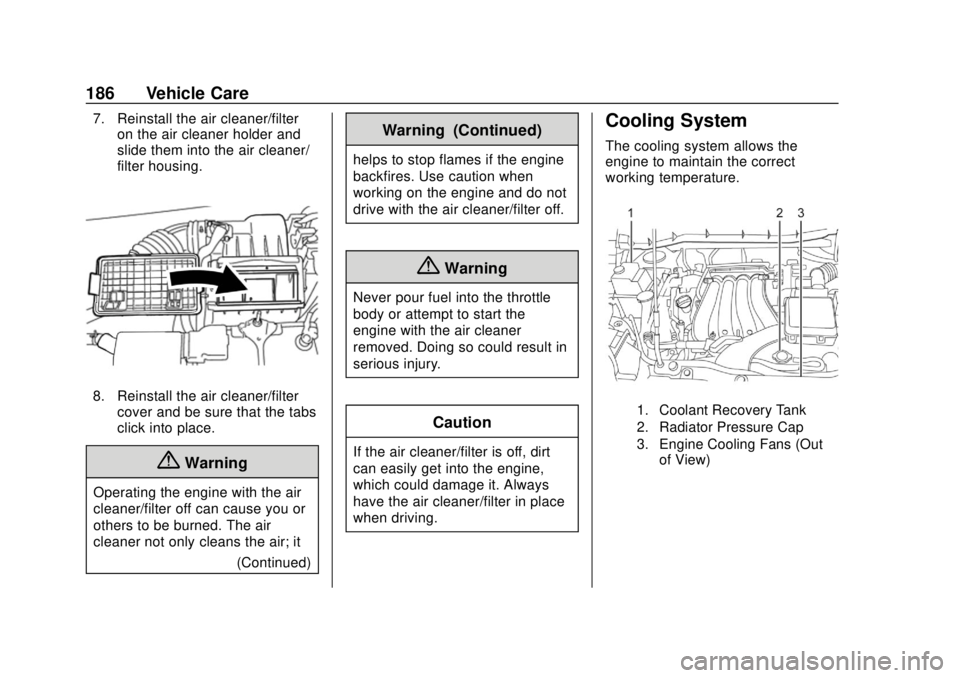
Chevrolet City Express Owner Manual (GMNA-Localizing-U.S./Canada-
11683523) - 2018 - CRC - 7/10/17
186 Vehicle Care
7. Reinstall the air cleaner/filteron the air cleaner holder and
slide them into the air cleaner/
filter housing.
8. Reinstall the air cleaner/filter
cover and be sure that the tabs
click into place.
{Warning
Operating the engine with the air
cleaner/filter off can cause you or
others to be burned. The air
cleaner not only cleans the air; it
(Continued)
Warning (Continued)
helps to stop flames if the engine
backfires. Use caution when
working on the engine and do not
drive with the air cleaner/filter off.
{Warning
Never pour fuel into the throttle
body or attempt to start the
engine with the air cleaner
removed. Doing so could result in
serious injury.
Caution
If the air cleaner/filter is off, dirt
can easily get into the engine,
which could damage it. Always
have the air cleaner/filter in place
when driving.
Cooling System
The cooling system allows the
engine to maintain the correct
working temperature.
1. Coolant Recovery Tank
2. Radiator Pressure Cap
3. Engine Cooling Fans (Outof View)
Page 188 of 287
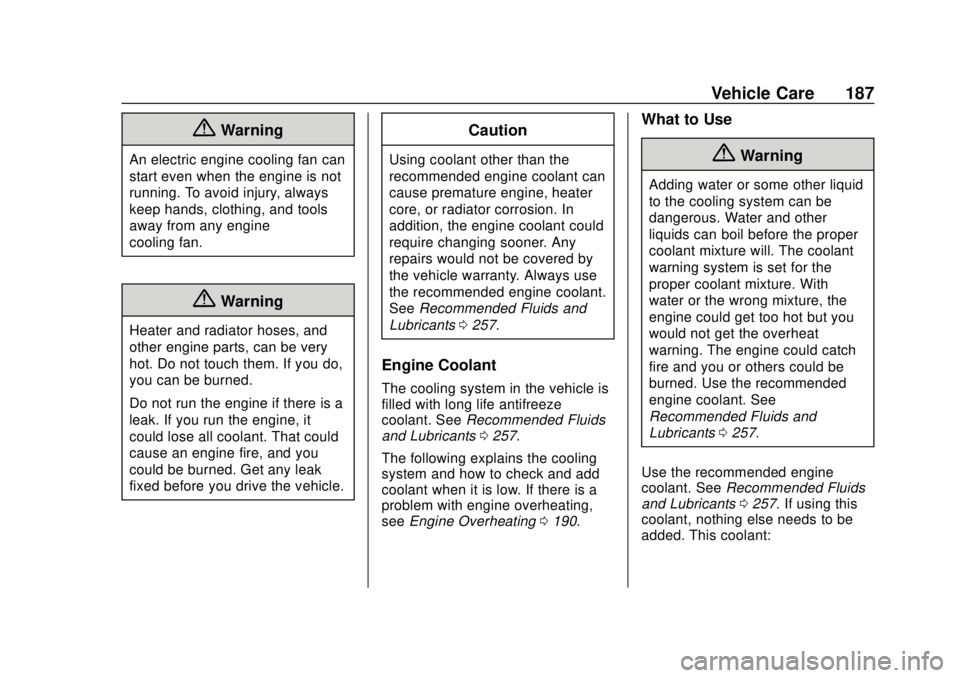
Chevrolet City Express Owner Manual (GMNA-Localizing-U.S./Canada-
11683523) - 2018 - CRC - 7/10/17
Vehicle Care 187
{Warning
An electric engine cooling fan can
start even when the engine is not
running. To avoid injury, always
keep hands, clothing, and tools
away from any engine
cooling fan.
{Warning
Heater and radiator hoses, and
other engine parts, can be very
hot. Do not touch them. If you do,
you can be burned.
Do not run the engine if there is a
leak. If you run the engine, it
could lose all coolant. That could
cause an engine fire, and you
could be burned. Get any leak
fixed before you drive the vehicle.
Caution
Using coolant other than the
recommended engine coolant can
cause premature engine, heater
core, or radiator corrosion. In
addition, the engine coolant could
require changing sooner. Any
repairs would not be covered by
the vehicle warranty. Always use
the recommended engine coolant.
SeeRecommended Fluids and
Lubricants 0257.
Engine Coolant
The cooling system in the vehicle is
filled with long life antifreeze
coolant. See Recommended Fluids
and Lubricants 0257.
The following explains the cooling
system and how to check and add
coolant when it is low. If there is a
problem with engine overheating,
see Engine Overheating 0190.
What to Use
{Warning
Adding water or some other liquid
to the cooling system can be
dangerous. Water and other
liquids can boil before the proper
coolant mixture will. The coolant
warning system is set for the
proper coolant mixture. With
water or the wrong mixture, the
engine could get too hot but you
would not get the overheat
warning. The engine could catch
fire and you or others could be
burned. Use the recommended
engine coolant. See
Recommended Fluids and
Lubricants 0257.
Use the recommended engine
coolant. See Recommended Fluids
and Lubricants 0257. If using this
coolant, nothing else needs to be
added. This coolant:
Page 189 of 287
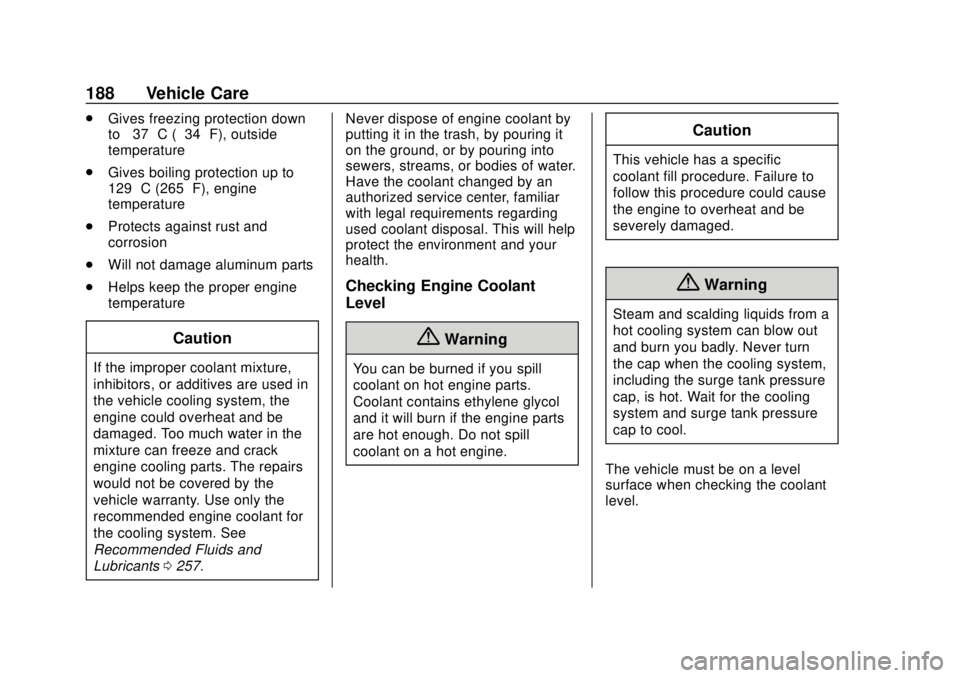
Chevrolet City Express Owner Manual (GMNA-Localizing-U.S./Canada-
11683523) - 2018 - CRC - 7/10/17
188 Vehicle Care
.Gives freezing protection down
to−37 °C (−34 °F), outside
temperature
. Gives boiling protection up to
129 °C (265 °F), engine
temperature
. Protects against rust and
corrosion
. Will not damage aluminum parts
. Helps keep the proper engine
temperature
Caution
If the improper coolant mixture,
inhibitors, or additives are used in
the vehicle cooling system, the
engine could overheat and be
damaged. Too much water in the
mixture can freeze and crack
engine cooling parts. The repairs
would not be covered by the
vehicle warranty. Use only the
recommended engine coolant for
the cooling system. See
Recommended Fluids and
Lubricants 0257. Never dispose of engine coolant by
putting it in the trash, by pouring it
on the ground, or by pouring into
sewers, streams, or bodies of water.
Have the coolant changed by an
authorized service center, familiar
with legal requirements regarding
used coolant disposal. This will help
protect the environment and your
health.
Checking Engine Coolant
Level
{Warning
You can be burned if you spill
coolant on hot engine parts.
Coolant contains ethylene glycol
and it will burn if the engine parts
are hot enough. Do not spill
coolant on a hot engine.
Caution
This vehicle has a specific
coolant fill procedure. Failure to
follow this procedure could cause
the engine to overheat and be
severely damaged.
{Warning
Steam and scalding liquids from a
hot cooling system can blow out
and burn you badly. Never turn
the cap when the cooling system,
including the surge tank pressure
cap, is hot. Wait for the cooling
system and surge tank pressure
cap to cool.
The vehicle must be on a level
surface when checking the coolant
level.
Page 190 of 287
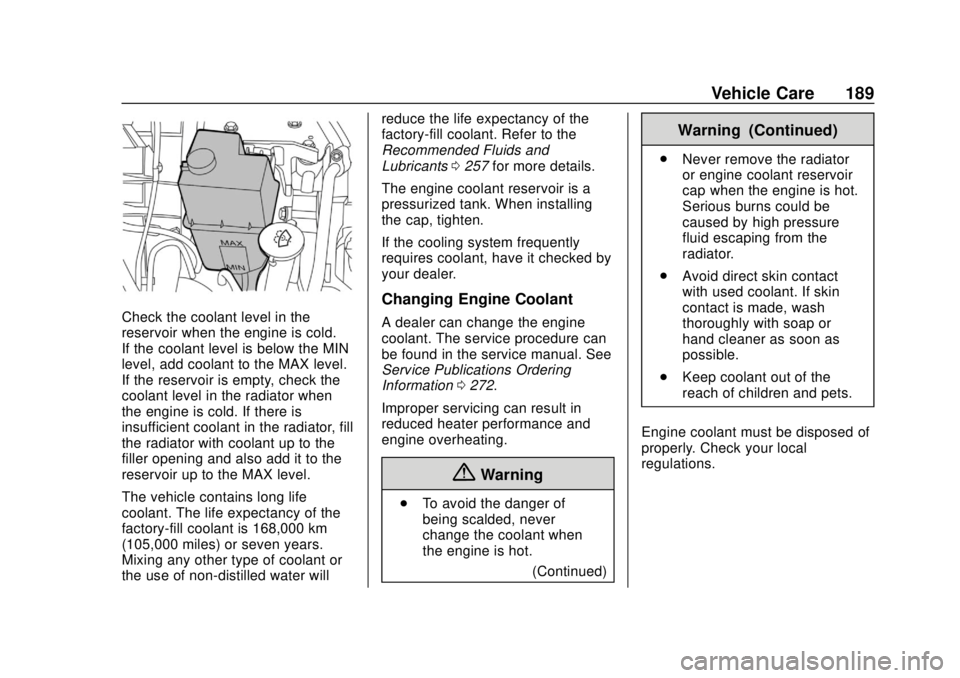
Chevrolet City Express Owner Manual (GMNA-Localizing-U.S./Canada-
11683523) - 2018 - CRC - 7/10/17
Vehicle Care 189
Check the coolant level in the
reservoir when the engine is cold.
If the coolant level is below the MIN
level, add coolant to the MAX level.
If the reservoir is empty, check the
coolant level in the radiator when
the engine is cold. If there is
insufficient coolant in the radiator, fill
the radiator with coolant up to the
filler opening and also add it to the
reservoir up to the MAX level.
The vehicle contains long life
coolant. The life expectancy of the
factory-fill coolant is 168,000 km
(105,000 miles) or seven years.
Mixing any other type of coolant or
the use of non-distilled water willreduce the life expectancy of the
factory-fill coolant. Refer to the
Recommended Fluids and
Lubricants
0257 for more details.
The engine coolant reservoir is a
pressurized tank. When installing
the cap, tighten.
If the cooling system frequently
requires coolant, have it checked by
your dealer.
Changing Engine Coolant
A dealer can change the engine
coolant. The service procedure can
be found in the service manual. See
Service Publications Ordering
Information 0272.
Improper servicing can result in
reduced heater performance and
engine overheating.
{Warning
. To avoid the danger of
being scalded, never
change the coolant when
the engine is hot.
(Continued)
Warning (Continued)
.Never remove the radiator
or engine coolant reservoir
cap when the engine is hot.
Serious burns could be
caused by high pressure
fluid escaping from the
radiator.
. Avoid direct skin contact
with used coolant. If skin
contact is made, wash
thoroughly with soap or
hand cleaner as soon as
possible.
. Keep coolant out of the
reach of children and pets.
Engine coolant must be disposed of
properly. Check your local
regulations.